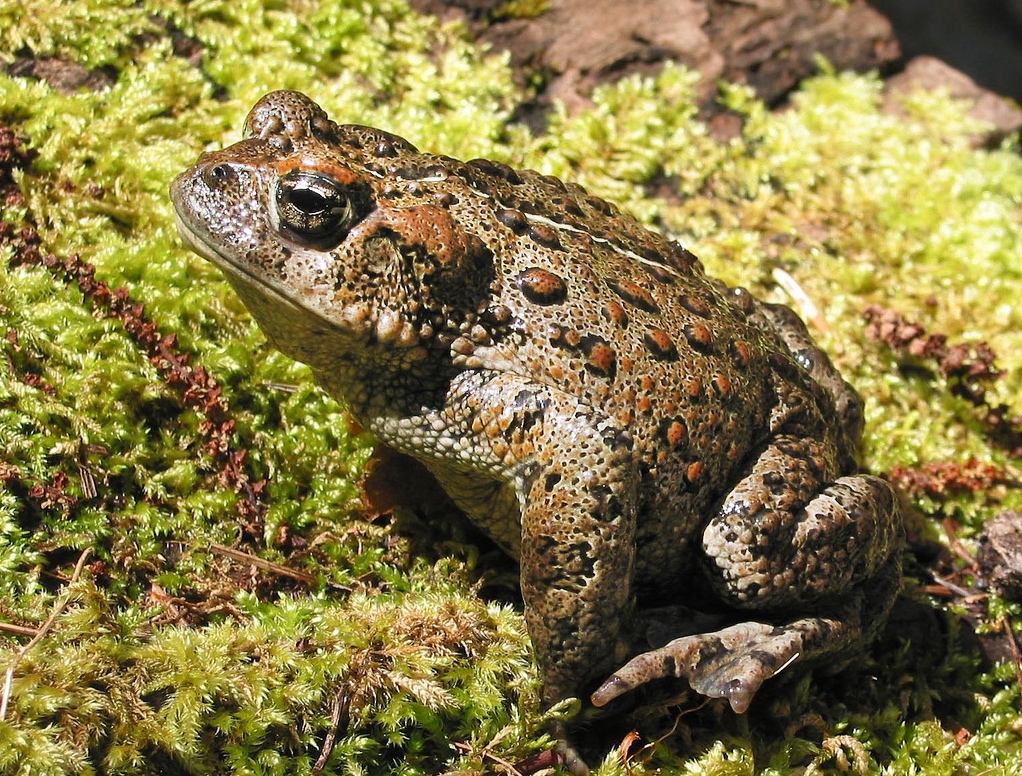Western Toad
Western toad (Anaxyrus boreas)
Taxonomy
| Kingdom | Phylum | Class | Order | Family | Genus | |
|---|---|---|---|---|---|---|
| Classification | Animalia | Chordata | Amphibia | Anura | Bufonidae | Anaxyrus |
Description
The Western Toad is a species of amphibians ranging in 2 to 5 inches in length with dusky gray or greenish dorsals, and skin glands concentrated inside the dark blotches. Western Toads also have a very distinguishable white or cream dorsal stripe. It has round, widely divided parotid glands that are larger than the upper eyelids and it lacks cranial crests but has a speckled ventro and horizontal pupils. Male western toads are unique for the fact that they develop smoother skin during breeding seasons. They also have less dorsal blotching, and nuptial pads (thickened skin) on their forefeet in comparison to females. Males are also smaller than female Western Toads. The dorsal stripe of this species' juveniles is missing or very faint. Yellow foot and vivid dorsal and ventral markings are features of large young.
Western Toad tadpoles are dark in appearance with light spotting on the body creating a gold shimmer when viewed in bright lights. Their underside is slightly paler than their overall body. The juveniles' eyes are dorsally situated on the top of their head ending in a tail which is dark in color with fins darker than the rest of of the tail itself.
Range and Subspecies
Western toads are known to inhabit a fairly wide territorial range, spanning across western British Columbia, northern Baja California, southern Alaska, Oregon, Idaho and Washington, central and western Wyoming, western Colorado, and the higher plateaus and mountains of Utah. This species occurs in a variety of terrestrial habitats including prairies, forests, canyon grasslands and ponderosa pine-Oregon oak habitat. They appear absent from most of the shrubsteppe and steppe zones with the exception of the canyon grasslands in southeast Washington. Breeding waters are usually permanent and include wetlands, ponds, lakes, reservoir coves and the still-water off-channel habitats of rivers, as well as river edges.

- There are two subspecies of the Western toad, namely Anaxyrus boreas boreas and Anaxyrus boreas halophilus
| Image | Scientific name | Common Name | Description | Distribution |
|---|---|---|---|---|
 |
Anaxyrus boreas boreas | Boreal toad | is characterized by an underbelly zone spotted with a decent amount of dark blotches, while the cranial crest is absent. | Boreal toads inhabit southern Alaska and western British Columbia, western Montana, Nevada, northern California, Oregon, Idaho, Washington, western Utah, and western Wyoming |
 |
Anaxyrus boreas halophilus | California toad | differs from the Western toads by possessing larger eyes, a wider head, and considerably smaller feet. California toads are also known to have weaker developed dorsal stripe zone margins. | Found across the Central Valley of California through Coastal and Baja California, as well as in western Nevada |
Life Cycle and Behavior
The Western Toad's lifecycle begins as eggs which are laid in long strings on bare sediments or intertwined in vegetation in shallow water near shore. Individual females produce approximately 12,000 eggs per clutch on average and tend to lay them around vegetation in still water. Depending on temperature and location, mating can being as early as March and ends in July. The males will find a shallow spot in wetlands or ponds and call to attract females. Males generally only call at night but will call during wet days during the peak of mating season. [1] Once the mating takes place the female will lay from 2,000-20,000 eggs in a long strand. The eggs will hatch after 3-12 days, typically from around June to August. Once the eggs hatch, they develop into tadpoles and become fully grown in 60 days. An American Toad will reach sexual maturity after 2-4 years. Once the toads reach adulthood they feed during the early morning into the night, as they are mainly nocturnal. American toads often hide in leaf litter to avoid predators. The toads will burrow in moist soils and hibernate in these burrows during the winter.
Diet and Predators
When American toads start off as tadpoles, they are herbivorous and primarily feed on decaying plants. When they become adults, they become carnivorous and eat small creatures such as insects, spiders, worms, and snails. The predators of the American toad include birds, snakes, and small mammals such as raccoons and skunks. There are certain snakes, such as the eastern hognose snake, which is specialized in eating toads due to its immunity to the American toad's bufotoxin. Toads often pee on themselves to make themselves a less appealing meal when they are facing a predator that is unaffected by their toxins. Another defensive behavior is that toads will enlarge their bodies by puffing up to seem too large for a snake to consume.
References
Altig, Ronald, et al. Handbook of Larval Amphibians of the United States and Canada. 1st ed., Cornell University Press, 2015. JSTOR, www.jstor.org/stable/10.7591/j.ctt1tm7g59. Accessed 12 Apr. 2021.
(“Eastern American Toad Fact Sheet - Signs of the Seasons: A New England Phenology Program - University of Maine Cooperative Extension”) “IUCN Red List of Threatened Species.” IUCN Red List of Threatened Species, https://www.iucnredlist.org/species/54570/56843565. Accessed 12 Apr. 2021.
Pauly, Gregory B., et al. “THE HISTORY OF A NEARCTIC COLONIZATION: MOLECULAR PHYLOGENETICS AND BIOGEOGRAPHY OF THE NEARCTIC TOADS (BUFO).” Evolution, no. 11, The Society for the Study of Evolution, 2004, p. 2517. Crossref, doi:10.1554/04-208.
Vaughan, Andres, and Joseph R. Mendelson. “Taxonomy and Ecology of the Central American Toads of the Genus Crepidophryne (Anura: Bufonidae).” Copeia, no. 2, American Society of Ichthyologists and Herpetologists (ASIH), May 2007, pp. 304–14. Crossref, doi:10.1643/0045-8511(2007)7[304:taeotc]2.0.co;2.
“IUCN Red List of Threatened Species.” IUCN Red List of Threatened Species, https://www.iucnredlist.org/species/54570/56843565. Accessed 12 Apr. 2021.
